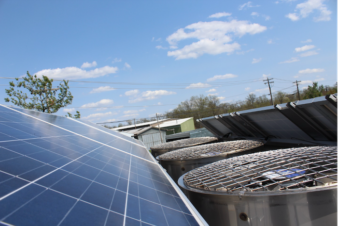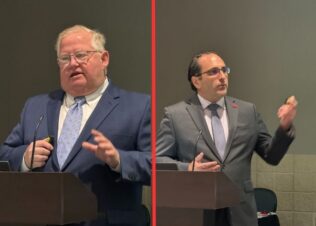Harol Harold Esmailka, 85, a native Athabaskan who grew up in the Alaskan tribe’s traditional nomadic lifestyle, is a true entrepreneur, having started a variety of businesses over the years. His bush plane service made him an aviation legend in the back country, and he and his wife still operate a general store out of his hilltop home overlooking the Yukon.
The home/store is a typical remote Alaskan trading post; butter, blankets, bullets and beer. Lots of beer. It’s the next best thing to Walmart, which is 240 air miles away; the same distance to the nearest plumbing supply house.

For technicians at Rocky’s Heating Service in Fairbanks, AK, this is often how a morning commute starts.
The store’s old boiler started leaking from a cracked section, so Harold started looking for a solution over the summer. In the meantime, he had an oil-fired Burnham V85 shipped to Ruby on a barge, to await its coming installation. This boiler is popular in AK because it’s available as a “breakdown” boiler that can be assembled on-site – a big plus for remote applications which often require flying, barging, or snowmobile transportation of boilers.
After speaking with supply houses in Fairbanks, Harold learned that Rocky’s Heating Service, out of Fairbanks, had completed a boiler installation in the village where his daughter lives. A few more phone calls for references, and Rocky’s was called for the job.
The company was founded by Rocky and Catherine Pavey in 1994, and currently has 17 employees that serve most of the Alaskan interior. Robust hydronic systems comprise most of their work. Exceeding customer expectations is the ultimate goal of every Rocky’s technician.
One Tuesday morning in November, just as the Yukon started to freeze over, Pavey was able to make the flight out to Ruby himself.
It’s the logistics
Pavey packed 160 pounds of tools, pipe and parts to be flown out ahead of him on a dedicated freight flight. To conserve space, small diameter pipe was stashed inside larger pieces, and everything else was packed into one big tote. “You can’t get on a plane with MAPP gas, so I traded the torch for a press system and fittings,” he said.
The temperature dropped to -5°F the evening his plane touched down in Ruby. Not wanting to take Harold’s leaky boiler out of service overnight, he serviced three other boilers in town on Tuesday evening. Before going to bed, he added Fernox liquid cleaning agent to the four-zone hydronic system at the general store to circulate overnight.
On Wednesday morning he drained the system. The fluid looked like mud due to the constant addition of untreated makeup water. After tearing out the old unit, he moved the circulator from the return piping to the supply side.
“Once you’re there with all the tools and material, installing a V8 is a cakewalk,” said Pavey. “We use them because it’s a tough boiler that’s quick and easy to install. When we’re in the remote villages, time is of the essence, and durability is a huge factor.”
At 85% efficient, the Burnham V8 is a cast iron boiler built to offer low cost of ownership and easy drop-in replacement for most systems. Seven sizes are available, from .75-2.6 GPH.
“The zone valves and wiring were a bit messy, but Harold wanted to replace as little as possible,” said Pavey. “When I was pulling materials back in Fairbanks, he told me that the expansion tank was in good shape. I learned otherwise when I got there.”
Luckily, there was an air freight shipment headed to Ruby on the morning he was to fly home.

When the new boiler was installed, the owner insisted on changing the piping as little as possible to trim costs.
While Pavey was piping the new boiler and running fresh soft-copper, his guys back in Fairbanks took an expansion tank to the airport. Wednesday night, Pavey filled the new boiler and left the old expansion tank in place. What he hoped to accomplish on Wednesday drifted into Thursday. He still had an expansion tank to replace and glycol to add to the system. As a result, he moved his flight home from Thursday morning to the afternoon.
Insurance policy
When the morning’s first flight arrived from Fairbanks, Pavey met it at the airfield to get the new tank. At that point, the countdown began. He had exactly two hours to swap tanks and add antifreeze and corrosion inhibitor to the system before his flight back to Fairbanks departed.
“Harold decided he wanted antifreeze in the system,” said Pavey. “Good idea, but is came at a cost. The air freight alone on 30 gallons of 50/50 propylene glycol was $307.”
But according to Pavey, both the antifreeze and the Fernox corrosion inhibitor are an insurance policy, a guard against the worst Mother Nature can throw at a heating system. Nights dropping below -50°F and wicked winds to accompany it make for long runtimes in a long heating season.
Just before Pavey headed to the airfield, Harold stopped him to ask if the system was actually running. He was concerned because his baseboard wasn’t gurgling, despite the building being warmer than ever. After explaining that the hydronic system was meant to be silent, and that the noise he’d grown accustomed to was a result of air in the pipes, Pavey caught his plane with minutes to spare.
Hard knock life
“Folks out here don’t have a lot to spend, but nobody in the country is more cognizant of their heating system than interior Alaskans,” explained Pavey. “Last year, fuel oil was $6.00 per gallon in the villages, and it doesn’t matter what the current barrel price is in the Gulf.”
Oil is barged to Ruby in the summer. When the town’s 75,000 gallons of storage is topped off, the price doesn’t change till the following year.
Harold was thrilled—and a bit surprised—that a professional heating outfit would make the trip to Ruby. With any luck, his position in the tribe will help spread the word of a job well done.
“Not long ago, we were only doing about one remote boiler installation each year,” said Pavey. “Since then, that number has crept up. The native community is tight knit, and the word has spread that we’re helping extend the life of systems while also lowering fuel bills. It’s an area where we expect to see growth in the years to come.








Join the conversation: